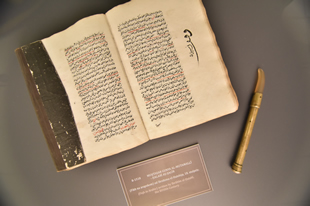Museum
The building of Gazi Husref-Beg’s Library has been enriched with another cultural content that represents and complements its centuries-old tradition. It is a Museum that, through its permanent exhibition, offers visitors an interesting encounter with the Islamic tradition of Bosniaks in this area. They come from different environments – home, mosque, tekke, craft. The majority of the artefacts was donated to the library, whose collection exceeds 1,200 items.
In the foyer of the Museum there is a lapidary, a collection of works in stone which is the persistent and faithful witness of the time in which they were created, people who carved them with their own hands or those who had them made.
The museum exhibition is divided into several thematic units according to the type of artefacts, their purpose and their usage, thus the exhibition consists of the following units:
ISLAMIC CALIGRAPHY
Islamic art was especially expressed through the beautiful writing of the text – calligraphy, and its own ornamentation known as arabesque. By nurturing this type of artistic expression occurred the development of the richest and most diverse-known calligraphy with many different types of letters (kufi, nesh, sulus, ta’lik, divani…) and ways of writing (in the form of a circle, in a mirror, in the form of a picture of an object, a bird, etc.). The beauty of this art lies in the artist’s hand, his skills and the ability to bring the incomprehensible divine reality closer to the human spirit and intellect.
The museum collection represents calligraphic works of our top calligraphers such as Hafiz Husein Rakim-efendi Islamović, Ahmed Seid Vilić, Mehmed-beg Kapetanović Ljubušak, as well as other calligraphers and teachers of calligraphy in Bosnia and Herzegovina.
TIME MEASUREMENT
Concept of time was an important part of a daily life of a devout Muslim as religious duties in Islam are time-framed. Religious duties: daily prayer, fast, pilgrimage (hajj), tax (zakat), and important events were related to a certain time in the lunar year. In order to calculate the exact time of these duties, our astronomers and muvekkits were required to become familiar with astronomy and numerous scientific tools used for this purpose – astrolabes, quadrants (rub-tahte), sextants, sundials and mechanical clocks. Muvekkit was engaged in measuring time and determining religious holidays. Muvvekit was also responsible for the functioning of clock towers in big and small towns in Bosnia and Herzegovina. The two globes handmade by the famous muvekkit in Sarajevo, Salih Sidki-efendija Hadžihusejnović Muvekkit, stand out as a specific feature of this museum exhibition.
ULEMA
Bosnia and Herzegovina has always had an elite ulema (religious scholars) who were educated in domestic schools and madrasas (religious schools) as well as throughout the Islamic world, and the Western world later on. Many of them have distinguished themselves in various scientific fields, especially in the field of classic Islamic science. Among the artefacts in this unit are manuscripts or printed texts of individual authors, commentators or copyists of manuscripts. We will only list some names: Mehmed Mejlija Bosnevi, Sejfullah Proho, Hasan Pruščak, Allāmek Muhammed Bosnevi, Mehmed Handžić, Mustafa Ejubović Šejh Jujo, Arif Hikmet Rizvanbegović-Stočević, Fadil-paša Šerifović. Photographs of Bosniaks highly respected ulema were also displayed, as well as their clothes and personal items.
MOSQUE AND TEKKE
The construction of mosques began up on the arrival of Islam in Bosnia and Herzegovina, The oldest mosque in BiH is considered to be Emin-Beg Mosque in Ustikolina near Foča, built in 1448. Some of the mosques with the most beautiful architectural characteristics are: Gazi Husrev-beg Mosque, Emperor’s Mosque and Ali Pasha’s Mosque in Sarajevo, Karagöz-Beg Mosque in Mostar, Hadži Alijina Mosque in Počitelj and Kuršumlija Mosque in Maglaj.
Aladža Mosque in Foča and Ferhadija Mosque in Banja Luka were both destroyed, and rebuilt in recent years. Sinan-beg Mosque in Čajniče was completely damaged during the war, and is currently in the reconstruction phase. Since dervishes came to Bosnia with the Ottoman army, tekkes were erected among the first buildings in the conquered settlements and newly established towns. Tekke (dervish house) in Bendbaša in Sarajevo was among the first to be built in Bosnia and Herzegovina. The most famous tekke are Hadži Sinan’s tekke in Sarajevo, the Blagaj Tekke on the banks of River Buna near Mostar, and the Tekke at Oglavka and Vukeljići near Fojnica.
The items presented in this ensemble were used to decorate the interiors of mosques and tekkes, for example: pictures with calligraphy (levhas), chandeliers, candlesticks, Qur’an book holder (rahla), prayer beads (tasbeeh), hand-woven carpets and prayer mats (sajjadas), buhurdar, julsija and other items.
HAJJ
Hajj, as the fifth fundamental duty for all Muslims, is visiting the holy places of Mecca and Medina at a specific time of the year which involves performing certain religious requirements. The return from the hajj is also marked by the custom of bringing various gifts to family members, relatives and friends, such as pots with zemzem-water, Åben fragrances, tasbeeh, sajjadas, perfume bowls, qiblats, silk and other fine materials, manuscripts and books. So, some of artefacts related to hajj can be found in the museum exhibition.
EVERYDAY LIFE
The daily life of a Muslim man was mainly concentrated around the bazaar, while life of a Muslim woman was happening out of the public eye and inside the house. Therefore, women often spent time at the embroidery or apartments for embroidery and weaving, creating beautiful colourful handicrafts for the house (towels, čevrma, boščaluke, carpets, sajdah), men’s (čakšire, vests, traboloze) and women’s costumes (veils, libades, barley, anthers, etc.). Wealthier women could afford more expensive embroidery equipment, so they engaged in clothes embroidery with gold wire and silk (shirts, vests, libades, anthers) and designing jewelry made of gold and silver (buckles and belts). Women from less wealthy families had modest equipment to use for embroidery. The equipment was kept in decorated treasure chests (seharas). The artefacts exhibited in this part of the museum showcase their beauty and diversity, and represent Bosniaks tradition that stems from Islamic roots.






